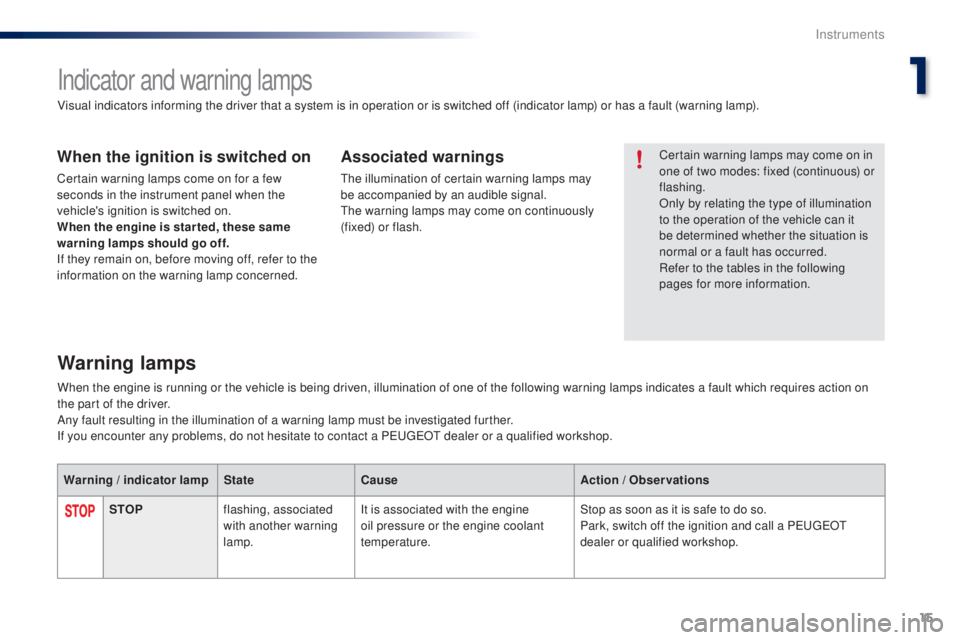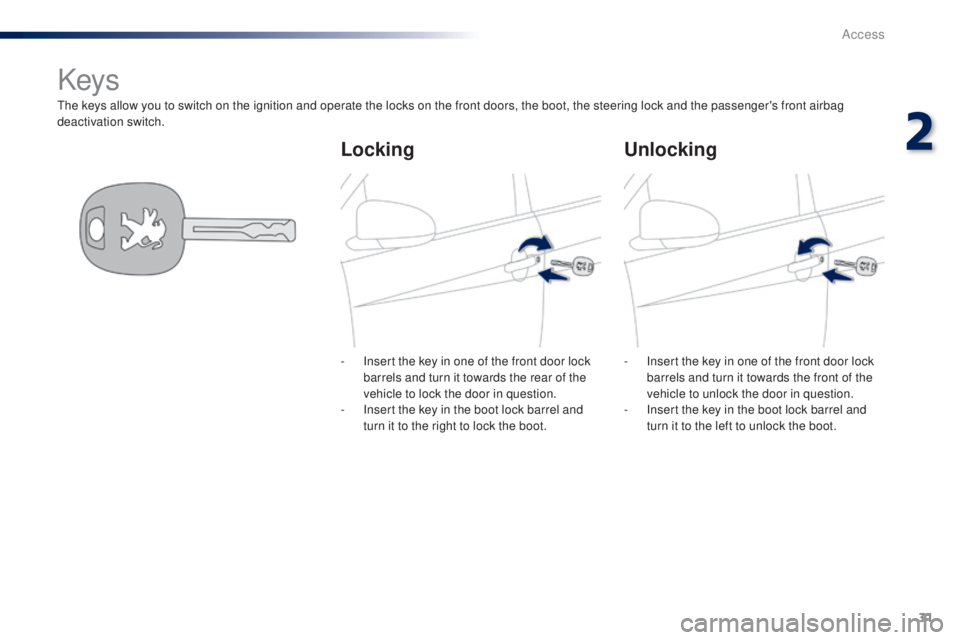2016 PEUGEOT 108 ignition
[x] Cancel search: ignitionPage 9 of 268

7
108_en_Chap00b_vue-ensemble_ed01-2016
Opening the bonnet 146Steering wheel, adjusting the height
5
1
Horn 10 6
Driver's front airbag 1 19Ignition, starting/switching off (key)
7
1-72
Ignition, starting/switching off ("Keyless e
n
try and Starting"
system)
7
2-74
Steering mounted controls
- t
o
uch screen, Radio
1
88, 241
-
L
ane departure warning
system 93 -94
Instruments and controls (continued)
Lighting controls 9
8-102
Direction indicators 1 03
Stop & Start
8
3 - 85
Active City Brake
1
10 -114
Adjusting the mirrors
5
0
Adjusting the headlamp beam heightt
1
03
Deactivating the CDS/
t
R
C
1
09 Wipers, screenwash control stalk
1
0 4 -10 5
Speed limiter (Pure
te
ch 82 engine)
8
6 - 88
Speed limiter (V
ti 6
8 engine)
8
9 -91
Opening the fuel
filler flap
1
38 Hazard warning lamps
1
06
Steering mounted controls
for the etg gearbox
7
7
.
Over view
Page 17 of 268

15
108 _en_Chap01_instrument- de-bord_ed01-2016
Indicator and warning lamps
Certain warning lamps may come on in
one of two modes: fixed (continuous) or
flashing.
Only by relating the type of illumination
to the operation of the vehicle can it
be determined whether the situation is
normal or a fault has occurred.
Refer to the tables in the following
pages for more information.
Visual indicators informing the driver that a system is in operation or is switched off (indicator lamp) or has a fault (warning lamp).When the ignition is switched on
Certain warning lamps come on for a few
seconds in the instrument panel when the
vehicle's ignition is switched on.
When the engine is star ted, these same
warning lamps should go off.
If they remain on, before moving off, refer to the
information on the warning lamp concerned.
Associated warnings
the illumination of certain warning lamps may
be accompanied by an audible signal.
th
e warning lamps may come on continuously
(fixed) or flash.
Warning lamps
StoP f lashing, associated
with another warning
lamp. It is associated with the engine
oil pressure or the engine coolant
temperature. Stop as soon as it is safe to do so.
Park, switch off the ignition and call a Pe
ugeOt
dealer or qualified workshop.
When the engine is running or the vehicle is being driven, illumination of one of the following warning lamps indicates a fault which requires action on
the part of the driver.
Any fault resulting in the illumination of a warning lamp must be investigated further.
If you encounter any problems, do not hesitate to contact a P
e
uge
Ot
dealer or a qualified workshop.
Warning / indicator lamp StateCause Action / o
b
servations
1
Instruments
Page 18 of 268

16
Brakingfixed.th e braking system fluid level has
dropped significantly.to p up with brake fluid recommended by Pe ugeOt.
I f the problem persists, have the system checked by a
P
e
uge
Ot
dealer or a qualified workshop.
th
e braking system has a fault. Stop as soon as it is safe to do so.Park, switch off the ignition and contact a P
e
uge
Ot
dealer or a qualified workshop.
Warning / indicator lamp
StateCause Action / o
b
servations
en
gine oil
pressure fixed, associated with
the S
tO
P warning
lamp.
th
e engine oil pressure is too low. Stop as soon it is safe to do so.Park, switch off the ignition and contact a P
e
uge
Ot
dealer or a qualified workshop.
Coolant
temperature flashing (V
ti 6
8
e
ngine
only).
the
temperature of the engine
coolant is increasing. Drive gently.
fixed.
the
temperature of the engine
coolant is too high. Stop as soon as it is safe to do so.
Wait until the engine has cooled down before
checking up the level; top up if necessary.
If the problem persists, contact a P
e
uge
Ot
dealer or
qualified workshop.
Anti-lock
Braking System
(ABS) fixed.
th
e anti-lock braking system has a
fault.
th
e vehicle retains conventional braking.
Drive carefully at reduced speed and contact a
P
e
uge
Ot
dealer or a qualified workshop without
d e l ay.
Instruments
Page 19 of 268

17
108 _en_Chap01_instrument- de-bord_ed01-2016
Low fuel levelfixed, accompanied by
an audible signal. When it first comes on there remains
approximately 5 litres of fuel
in the
tank. You must refuel as soon as possible to avoid running
out of fuel.
th
is warning lamp will come on every time the ignition
is switched on, until a sufficient addition of fuel is
made.
Fuel tank capacity: approximately 35 litres.
Never continue to drive until you run out of fuel as
this could damage the emission control and injection
systems.
Battery charge fixed.
th
e battery charging circuit has a
fault (dirty or loose terminals, slack or
cut alternator belt, ...). Contact a P
e
uge
Ot
dealer or a qualified workshop.
em
ission control
system fixed.
th
e emission control system has a
fault. Contact a P
e
uge
Ot
dealer or a qualified workshop
without delay.
en
gine fault
fixed. A major fault has been detected that
does not have a specific warning lamp. You must contact a P
e
uge
Ot
dealer or a qualified
workshop.
Dynamic
stability control
and traction
control (DSC/
tR
C)
flashing.
th
e DSC/
tR
C system is in action.
th
e system optimises traction and improves the
directional stability of the vehicle.
fixed.
th
e DSC/
tR
C system has a fault. Have it checked by a P
e
uge
Ot
dealer or a qualified
workshop.
Warning / indicator lamp
StateCause Action / o
b
servations
1
Instruments
Page 28 of 268

26
Indicators
total/trip distance
recorder
Press one of the buttons 1 to alternate the
distance display:
-
t
otal with " o
D
o
" (
odometer) displayed,
-
t
rip with "
t
RIP" displayed.
to r
eset the trip recorder to zero, when
it is displayed, press and hold one of the
two
buttons 1 .
When the ignition is switched on, the distance
recorder selected when the engine was
switched off is displayed.th
is indicates the quantity of fuel available:
- 1/ 1 and six bars, the fuel tank is full.
-
R
and one bar, the fuel tank is on the
reserve.
Low fuel level
Fuel gauge
At least 5 litres must be added after
running out of fuel.
You have approximately 5 litres remaining.
When the low level in the fuel tank is
reached, this warning lamp comes on
in the instrument panel, accompanied
by an audible signal.
Instruments
Page 30 of 268

28
With the touch screen
From the Menu page in the touch screen:
F Sel ect the " Vehicle information " tab.
th
e "
tr
ip information " window is displayed
with the following information:
-
"Average speed ",
-
"
ela
psed time ",
-
"Range ",
-
t
he current fuel consumption, presented in
graphical form.
th
e "
er
ase" button resets the fuel consumption
data in the touch screen and the instrument
panel. If your vehicle has a touch screen, you can
view information on the current journey.
trip computer, a few definitions
Range
(miles or km)th e distance which can still be travelled with
the fuel remaining in the tank (related to the
average fuel consumption over the last few
miles (kilometres) travelled).
th
is value may vary following a change
in the style of driving or the relief,
resulting in a significant change in the
current fuel consumption.
When the fuel level is low, the message
"Lo
F
u
e
L
" is displayed.
If only a small amount of fuel is added, the
range may not be recalculated.
Current fuel consumption
(mpg or l/100 km or km/l)
Calculated over the last few seconds.
Stop & Start time counter
(minutes / seconds or hours / minutes)
If your vehicle is fitted with Stop & Start,
a
time counter calculates the time spent in
S
tO
P mode during a journey.
It resets to zero every time the ignition is
switched on.
Average fuel consumption
(mpg or l/100 km or km/l)
Calculated since the last trip computer reset.
Average speed
(mph or km/h)
Calculated since the last trip computer reset.
Instruments
Page 33 of 268

31
108_en_Chap02_ouvertures_ed01-2016
the keys allow you to switch on the ignition and operate the locks on the front doors, the boot, the steering lock and the passenger's front airbag
deactivation switch.
Keys
Lockingun locking
- Insert the key in one of the front door lock
barrels and turn it towards the rear of the
vehicle to lock the door in question.
-
I
nsert the key in the boot lock barrel and
turn it to the right to lock the boot. -
I nsert the key in one of the front door lock
barrels and turn it towards the front of the
vehicle to unlock the door in question.
-
I
nsert the key in the boot lock barrel and
turn it to the left to unlock the boot.
2
Access
Page 39 of 268

37
108_en_Chap02_ouvertures_ed01-2016
Changing the battery of
the electronic key
Battery ref.: CR2032 / 3 volts.When replacement of the battery is
needed, this warning lamp comes on
in the instrument panel.
F
u
n
clip the cover using a small screwdriver
at the cutout.
F
R
emove the cover.
F
R
emove the protective battery holder,
pulling it upwards.
F
R
emove the discharged battery from its
housing.
F
F
it the new battery into its housing
observing the original direction of fitment.
F
R
efit the battery holder.
F
C
lip the cover onto the casing.
Lost keys
go to a PeugeOt dealer with the vehicle's registration document, your personal
identification documents and if possible the key code label.
th
e P
e
uge
Ot
dealer will be able to look up the key code and the transponder code
required to order a new key.
Remote control / el ectronic key
these high frequency devices are sensitive systems; do not handle them while in your
pocket as there is a risk of unlocking the vehicle, without you being aware of it.
Do not repeatedly press the buttons of your remote control or electronic key out of range
and out of sight of your vehicle. You run the risk of stopping it from working and the remote
control would have to be reinitialised.
Locking the vehicle
As a safety precaution, never leave children alone in the vehicle, except for a very short
period.
In all cases, it is essential to remove the key from the ignition switch, or take the electronic
key with you when leaving the vehicle.
When purchasing a second-hand vehicle
Have the pairing of all of the keys in your possession checked by a Pe ugeOt dealer, to
ensure that only your keys can be used to open and start the vehicle. Driving with the doors locked may make access to the passenger compartment by the
emergency services more difficult in an emergency.
2
Access